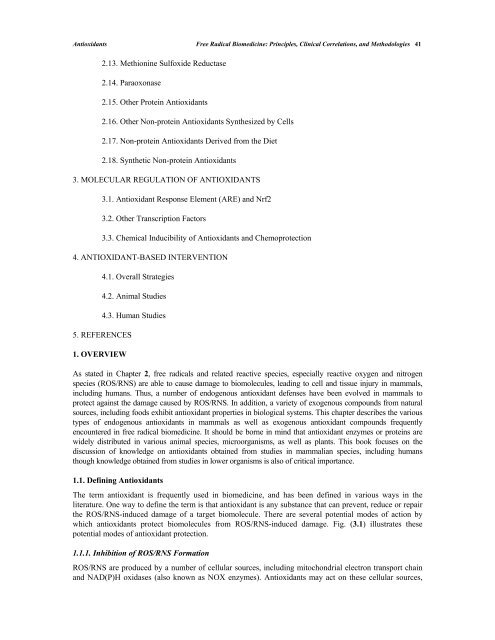Free Radical Biomedicine: Principles, Clinical ... - Bentham Science
Free Radical Biomedicine: Principles, Clinical ... - Bentham Science
Free Radical Biomedicine: Principles, Clinical ... - Bentham Science
Create successful ePaper yourself
Turn your PDF publications into a flip-book with our unique Google optimized e-Paper software.
Antioxidants <strong>Free</strong> <strong>Radical</strong> <strong>Biomedicine</strong>: <strong>Principles</strong>, <strong>Clinical</strong> Correlations, and Methodologies 41<br />
2.13. Methionine Sulfoxide Reductase<br />
2.14. Paraoxonase<br />
2.15. Other Protein Antioxidants<br />
2.16. Other Non-protein Antioxidants Synthesized by Cells<br />
2.17. Non-protein Antioxidants Derived from the Diet<br />
2.18. Synthetic Non-protein Antioxidants<br />
3. MOLECULAR REGULATION OF ANTIOXIDANTS<br />
3.1. Antioxidant Response Element (ARE) and Nrf2<br />
3.2. Other Transcription Factors<br />
3.3. Chemical Inducibility of Antioxidants and Chemoprotection<br />
4. ANTIOXIDANT-BASED INTERVENTION<br />
4.1. Overall Strategies<br />
4.2. Animal Studies<br />
4.3. Human Studies<br />
5. REFERENCES<br />
1. OVERVIEW<br />
As stated in Chapter 2, free radicals and related reactive species, especially reactive oxygen and nitrogen<br />
species (ROS/RNS) are able to cause damage to biomolecules, leading to cell and tissue injury in mammals,<br />
including humans. Thus, a number of endogenous antioxidant defenses have been evolved in mammals to<br />
protect against the damage caused by ROS/RNS. In addition, a variety of exogenous compounds from natural<br />
sources, including foods exhibit antioxidant properties in biological systems. This chapter describes the various<br />
types of endogenous antioxidants in mammals as well as exogenous antioxidant compounds frequently<br />
encountered in free radical biomedicine. It should be borne in mind that antioxidant enzymes or proteins are<br />
widely distributed in various animal species, microorganisms, as well as plants. This book focuses on the<br />
discussion of knowledge on antioxidants obtained from studies in mammalian species, including humans<br />
though knowledge obtained from studies in lower organisms is also of critical importance.<br />
1.1. Defining Antioxidants<br />
The term antioxidant is frequently used in biomedicine, and has been defined in various ways in the<br />
literature. One way to define the term is that antioxidant is any substance that can prevent, reduce or repair<br />
the ROS/RNS-induced damage of a target biomolecule. There are several potential modes of action by<br />
which antioxidants protect biomolecules from ROS/RNS-induced damage. Fig. (3.1) illustrates these<br />
potential modes of antioxidant protection.<br />
1.1.1. Inhibition of ROS/RNS Formation<br />
ROS/RNS are produced by a number of cellular sources, including mitochondrial electron transport chain<br />
and NAD(P)H oxidases (also known as NOX enzymes). Antioxidants may act on these cellular sources,

















